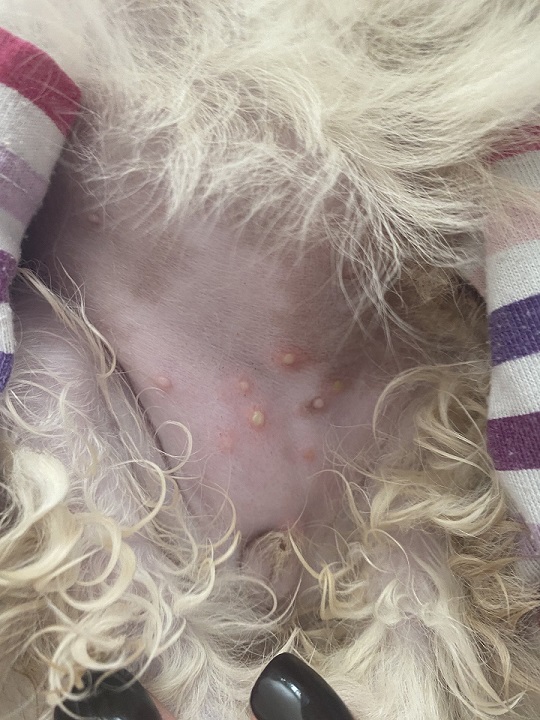If you’ve ever noticed pimples on your dog’s belly, you’re not alone. Many pet owners have wondered what they are and what they mean. In this post, we’ll discuss the most common causes of pimples on dogs and how to treat them. So if your pup is suffering from a case of the bumps, keep reading!
There are a few reasons why your dog might have pimples on her belly. The most common reason is that she has an infection, such as a yeast infection or a bacterial infection. Other possible causes of pimples on a dog’s belly include:
- Allergies
- Acne
- Skin parasites, such as ticks
- Sebum (skin oil) production, which is increased in some breeds
- Localized inflammation of the skin
- Poor grooming habits that irritate the skin
- Contact with irritating plants or other allergens, such as poison ivy.
Table of Contents
Can dogs get acne on their belly?
Yes, dogs can get acne on their bellies. Just like with people, the causes of acne can vary but may include hormonal changes, skin irritation, or bacteria. Acne in dogs is usually treated with topical medications or antibiotics, depending on the cause.
If your dog has pimples on her belly, it’s important to get them checked out by your veterinarian to determine the cause and begin treatment. Your vet will physically examine your dog and ask you questions about your pet’s medical history, including what she was doing when you noticed the pimples, how long they’ve been around, and if anything has changed in her environment recently. He or she may also conduct a skin scraping or culture to determine the cause of the acne and prescribe the best treatment.
Are pimples on dogs normal?
Acne is not normal in dogs or people. Acne is usually caused by hair follicles becoming plugged with fats, oils, bacteria, and shed skin cells. This can happen when the body produces too much of a certain hormone, which stimulates oil glands to produce more oil. Some breeds are more prone to acne than others. For example, Bulldogs, Boxers, and Boston Terriers are more prone to developing acne than other breeds.
Why is my dog getting pimples?

There are a variety of reasons why dogs may get pimples. Some common causes of acne in dogs include:
- Hormonal changes: Dogs can get acne during puberty, pregnancy, and menopause.
- Skin irritation: Acne may develop if the skin is irritated by something such as a collar that’s too tight, a rash caused by a fungal infection, or an allergic reaction to a new shampoo or food.
- Bacteria: Acne can be caused by bacteria such as Staphylococcus aureus or Malassezia pachydermatis.
Can I pop my dog’s pimples?
No, you should not pop your dog’s pimples. Popping pimples can cause them to become infected and may lead to scarring. It’s best to leave the pimples alone and let your veterinarian treat them.
How do I get rid of my dog’s pimples?
If your dog’s pimples are caused by allergies, it may be possible to identify what is causing the allergies and treat your dog accordingly. If your dog has a yeast infection, she will likely need to be treated with antibiotics or antifungal medications.
If your dog has a bacterial infection, she may need to be treated with antibiotics. If your dog’s pimples are caused by skin parasites, you will need to take steps to eradicate the parasites.
If your dog’s pimples are caused by sebum production, you may be able to reduce the amount of sebum produced by bathing your dog more frequently or by using a medicated shampoo.
If your dog’s pimples are caused by inflammation of the skin, you may need to apply a topical ointment or cream to help improve the condition of her skin. If your dog’s pimples are caused by poor grooming habits, you may need to brush her more often and clean her ears and anal area regularly.
If your dog’s pimples are caused by contact with an allergen, you will need to identify and avoid the allergen.
If your dog’s pimples persist for an extended period of time, or if they become increasingly worse, then you will need to take your dog in for a veterinary exam. It is possible that your dog may have allergies, seborrhea (overproduction of sebum), miliary dermatitis (a chronic skin inflammation), demodectic mange (a skin infection caused by the Demodex mite), or some other health concern.
The most common breed to develop the condition is the English Bulldog, but any dog breed may be affected. Dogs of all ages can be affected, but the condition is most commonly seen in dogs that are less than one year old.
If your dog has pimples on her belly, the best course of action is to take her to the veterinarian for a diagnosis. The veterinarian will be able to determine the cause of the pimples and prescribe the appropriate treatment.
In most cases, the pimples will improve with treatment, but in some cases, they may persist or recur. If you are unable to identify the cause of the pimples, or if they do not respond to treatment, take your dog to the veterinarian for further evaluation.
